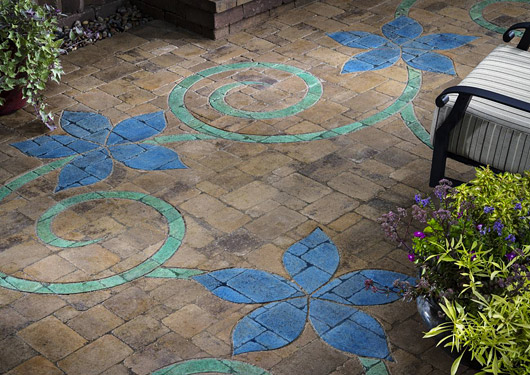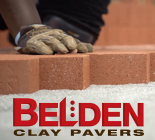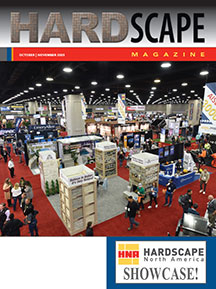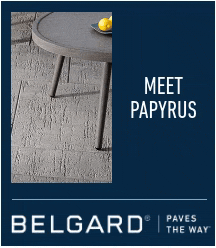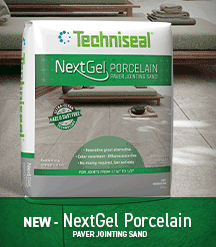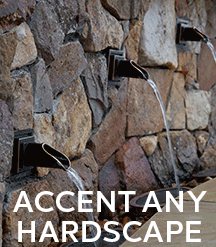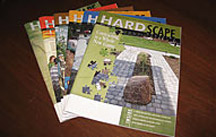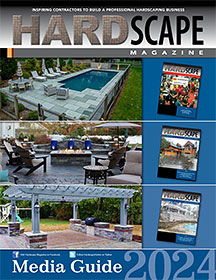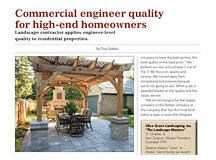Contractor Stories
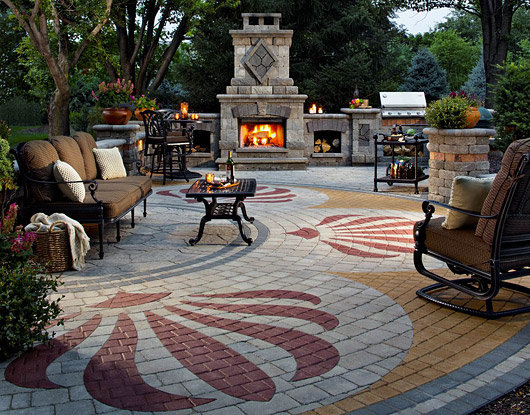
Paver Designs’ cutting perfection
Father, son, no employees, win national awards with inlay expertise in demand across the country.
By Tom HatlenOver the last 18 years father and son Jim and Justin Hampton have done things their way, making a living perfecting their hobby – hardscaping. In the process, they’ve become experts in cutting inlays to the point where their skills are called upon by clients several states away. But it’s hard to travel somewhere else when they have plenty of work close to home.
Local contractors also refer inlay jobs to them. Justin says, “We get calls from new clients all the time saying, ‘We had so and so out, and they said we should probably call Paver Designs. This is the type of work they do.'"
Their work has earned HNA project awards each of the last 4 years. With no employees, the 2 of them do all the work themselves and still generate a half million in annual sales designing/installing patios, outdoor kitchens and retaining walls. Nearly all their jobs involve inlays. None involve plants.
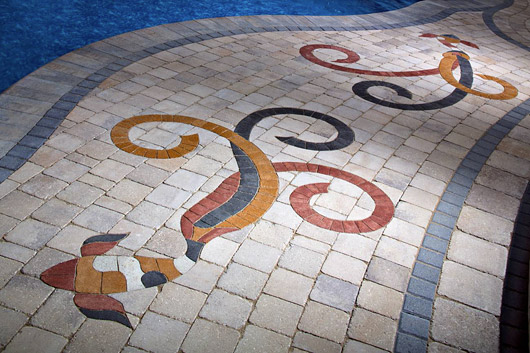
Work for fun
The secret to their success has been to focus on getting better at what they do, not on growth.“In our spare time, we'll draw out designs and just file them away until we come up with a project where it would work. We've got a whole file full of sketches and designs. We might buy a box of Kleenexes just because we liked the design.
“Over the winter, we're always practicing, learning new ways to make cuts and turns with the pavers, cutting things out a little bit easier, finding a new process. We’ll cut out designs in our shop, sitting there waiting to be used. It's not just a job; it's almost a hobby for us.”
But they’re not just about designs and cutting. Jim and Justin are always thinking about how to improve all facets of their work.
“Everything we do is a little different, even our base prep, the way we compact it, the distance we run our base out past the patios. We created our own base mixture, not just your straight crush run. We have our supplier mix different percentages of different types of rock into it. It’s made a major difference. It compacts so well that there are times you almost need to pre-drill holes to get your edging spikes into the base. We have no callbacks.”
Coming up with designs
Even though most clients come to Paver Designs for inlay work, most don’t have a specific design in mind. Justin says clients rely on them for ideas. No problem.“We talk to them, see what they're into, get a feel for what they're looking for. If there’s some sort of ornamental design hanging from the side of their house or somewhere out in the yard, we bring that up.
“We'll take all the measurements and draw up the plan for the project, and we'll hand-draw designs we think would look good in there. They might want a few changes to it. But usually they'll trust us, that we know what will look good.”
Justin says they try to design using radii that their table saws can cut cleanly as much as possible. “Otherwise, we’ll be doing a lot of grinding with our saws to get a real tight curve or a little inset piece.”
They avoid designing logos for sport teams or companies. “We get asked for Nebraska football logos all the time. We learned very quickly that you don't mess with any university’s logos without permission. They’re very strict about that. There's a process you can go through, but we just try to avoid it. We always tell people, ‘Someday you’re going to want to sell your house, and the next person might not want a big Nebraska N.’”
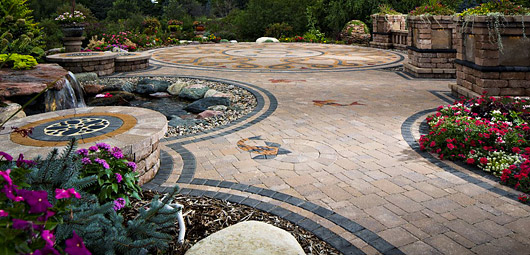
Equal partnership without employees
Just as there is no “I” in “team,” there is no “I” in Paver Designs LLC (aside from the spelling). Jim and Justin are equally involved in everything (aside from doing interviews with Hardscape Magazine).Justin says, “We both do it all. We're both out there installing. We both come up with the designs together easily. One of us will have an idea and the other one modifies it a little bit. It's pretty much a 50/50 thing with us.”
And they’re both just as intense in achieving near perfection in their work. Justin says, “That's why we don't have any employees. We tried it, and we'd spend the whole time looking over their shoulder or fixing what they were doing. So we made the decision to keep it just the 2 of us.
“I'm not jealous of the headaches that a lot of the other guys have with people not showing up, and some even breaking off and becoming your competition with everything you taught them.”
It also gives clients a great deal of confidence knowing that the owners, known for exceptional quality work, are doing all the work themselves. The drawback is that while Jim and Justin work quickly, they’re still just a 2-man crew.
“We tell customers up front that the job is going to take longer with just 2 people working on it, but it'll be done right when we're done. They know they're getting something custom that nobody else is going to have, so they're typically pretty excited to have us there.”
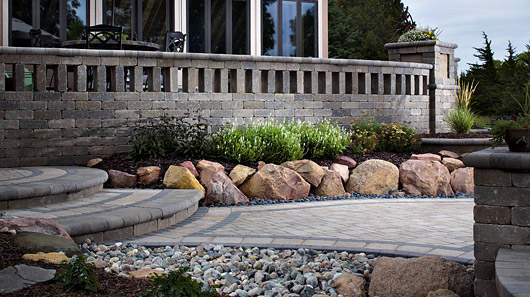
Project Profile
Paver Designs, LLC
Omaha, NEFounded 1995
Jim Hampton and Justin Hampton, Owners
Customer base
90% residential10% commercial
Services
100% hardscape2014 annual sales
$500,000Largest project
$98,000Employees
0Executing the design
Inlay work begins after the background field of pavers is installed. Then they draw the design onto the pavers in chalk. Most of the time it’s drawn freehand. Sometimes they cut stencils out of Masonite hardboard back at the shop. Once the homeowner approves it, they retrace everything in greater detail with carpenter pencils.Justin says the drawings on the pavers are nearly always tweaked from the original plan. “Once you lay a patio, you get a better feel for how it's going to look completed, so we make a few changes here or there.”
The tools for cutting inlays
Designing the inlays is one thing, cutting them out precisely is another challenge. First, they pull up each paver they’re going to cut. The pavers come up easy since there’s no sand in the joints yet.They’ve looked into specialty saws like diamond band saws that might make cutting inlays easier, but they haven’t found anything they like. Instead, they rely on 18 years of detail cutting experience with high RPM table saws and top quality diamond blades.
Their main table saw for cutting designs has a 12.5 hp motor. Their other table saw (7.5 hp motor) is most often used for making straight cuts when the main saw is in use. Both saws are outfitted with 14” blades. Justin says cheap blades wouldn’t hold up at the RPMs their motors generate.
“The key for us is the quality of the blade. We have some specially made for us. I don’t want to get too technical, but it’s all about the quality of the diamond and the way it's placed on the blade. Our average blade costs $400 to $600, but it makes a huge difference. If we used a cheap blade, we'd be cutting for days something that we can zip right through with a good one. It's unproductive.”
Even with the best equipment, inlay cutting can take lots of time. “We've cut on jobs for 12 days straight before – 12 days only doing cuts. It can be some pretty tedious work, but we think it's worth it for the outcome.”
Precision sealing an inlay
After an inlay is cut, set in place and compacted, but before the joint sand is installed, they seal the inlay to make it stand out. They usually use Techniseal’s NuLook or Color Boost products.“We hand-brush it on. If it's a red paver, we might use the red NuLook. It really makes those colors pop and seals all the colors in.”
They install polymeric sand once the inlay sealer is dry. Then, on about 60% of their projects they apply another sealer over the whole project.
Justin says sealing the inlay requires precise work like painting trim on a house. “It's actually harder to do than the paver cutting sometimes. You get down on your hands and knees with a painter's brush making sure you're not getting it on anything else.”
And the end result is near perfection.
